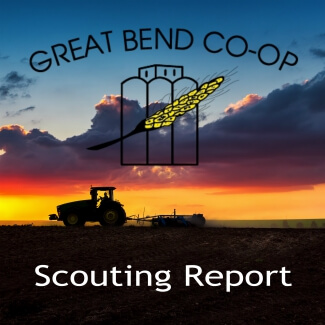Scouting Report - September 9, 2019
Sep 09, 2019

Corn – Corn ranges from Dough to Black Layer (Maturity). Finding moderate to heavy Southern Rust and Gray Leaf Spot. Fields treated with fungicides at Tassel are showing much better leaf health than those untreated fields. Some reports of storm damage, mostly tops broken out of plants above the ear, from recent severe weather.
Soybeans – Soybeans range from Full Flower to Full Seed Fill stages. Finding some light leaf feeding in most fields. Pod damage has been minimal so far. At R6 – Full Seed Fill there are still 20-30 days until harvest depending on the weather and environment.
Milo – Milo ranges from Flowering to Hard Dough Stages. Finding Headworm (Corn Earworm) at treatable levels in fields that are still in milk to soft dough stages. Sugar Cane Aphids can be found in many fields throughout Barton and surrounding counties. Most fields remain below treatment levels for SCA, however some have been treated due to the need to treat headworms as well.
Summer Fallow – Burndown treatments are working well so far. Spraying standing wheat stubble for grasses and volunteer cereal grains is imperative in preventing the “green bridge effect” that often leads to the infection of Wheat Streak Mosaic Virus. Volunteer grains and grasses should be dead for two weeks before your 2020 wheat crop emerges.
For more information on Wheat Streak Mosiac Virus from Kansas State University CLICK HERE
Soybeans – Soybeans range from Full Flower to Full Seed Fill stages. Finding some light leaf feeding in most fields. Pod damage has been minimal so far. At R6 – Full Seed Fill there are still 20-30 days until harvest depending on the weather and environment.
Milo – Milo ranges from Flowering to Hard Dough Stages. Finding Headworm (Corn Earworm) at treatable levels in fields that are still in milk to soft dough stages. Sugar Cane Aphids can be found in many fields throughout Barton and surrounding counties. Most fields remain below treatment levels for SCA, however some have been treated due to the need to treat headworms as well.
Summer Fallow – Burndown treatments are working well so far. Spraying standing wheat stubble for grasses and volunteer cereal grains is imperative in preventing the “green bridge effect” that often leads to the infection of Wheat Streak Mosaic Virus. Volunteer grains and grasses should be dead for two weeks before your 2020 wheat crop emerges.
For more information on Wheat Streak Mosiac Virus from Kansas State University CLICK HERE